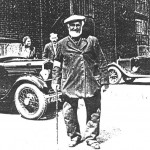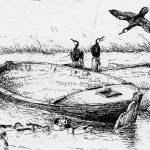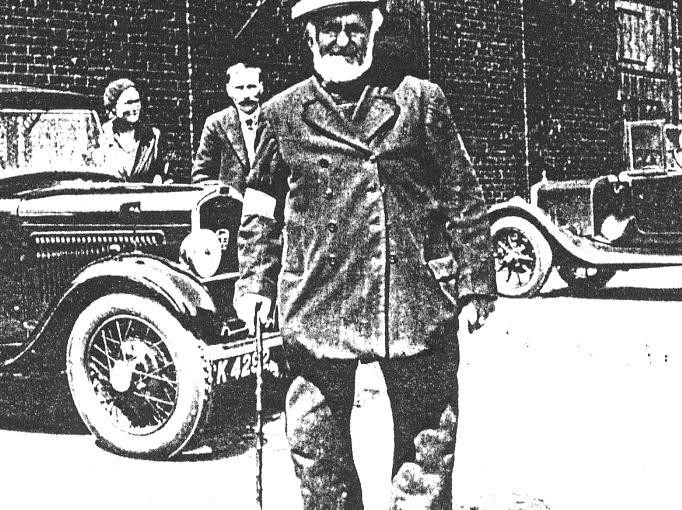Part Two
by Arthur Woodgate
In 1938 the steel piles were put in along the river to replace the old worn out ones, which were wooden and been there for many years. On 2nd July of that year, I was crossing the bridge into Winchelsea Road in a terrific thunder storm and witnessed the most spectacular natural sight I have seen. I just had to stop and get wet through and watch the electric flashes dancing on the piles almost the length of the strand. It didn’t seem to have done much damage as the concrete capping was later fixed without much difficulty.
Five years before the new piling the old wooden bridge had also been replaced with steel, concrete and brick. Some piles were needed for this too, so in moved a piledriver, platform and team. The vibration from the pile driving for the bridge and new sluice drove the near residents mad, but it was not only the vibration that upset the people, there was a general foreman with a loud foul mouth. He was also a bully to his men. Two of the pile-driving crew got so angry that they picked this terrorist up and flung him in the water. He floundered his way out and ran for his mobile office (mud and all). Locked himself in, and rang for the police, who must have been waiting for something like this, because they had a smile and pleasant talk with the crew, and took the foreman away. Eventually he was escorted out of the area and told he would not be welcomed back. With a new man in charge the new bridge and sluice came peacefully into being.
The bulk of the fishing fleet didn’t use the strand, as they tied up at the fishmarket or the harbour, much as they do now. From the 19th and well into the 20th Century, the fishing smacks were quite a size and there were over 50 of them, so it was just as well they didn’t want to crowd the busy Strand. The local river barges not only distributed the seaborne commodities up the rivers to the inland wharfs, but would quant ballast from the harbour bar and unload it on the Strand Quay for the use of builders and builder’s merchants. Quanting 25 tons of ballast was no small feat for two men. We boys were of course, inclined to play with the ballast unless and until we were chased off by officials of the river board or catchment authority. There was argument as to whether the men quanting were marking time while the barge passed under them or if they were walking the full length of the barge. Looking back one wonders why only one of our number was drowned in the strand.
Lets stay out of the water for a while, anybody seemed to able to use Quayside for anything. The most beautiful sight was the shire horses. When the haulage firm of “Wright and Pankhurst” brought them to be harnessed into the wagons and timber tugs which were left there overnight, another firm called “Barden”, came with their shire horses too, but they seemed to have only timber tugs, and it was common to see whole tree trunks left on the tugs all night and all the weekend. Shire horses were a common sight between the warehouses and corn stores. They would be munching away at food from their nosebags whilst the men were unloading corn and reloading the wagons with fodder and fertiliser. Some of these poor animals would have had to pull their loads up Rye hill, but they did have a water trough half way up the steep part. As horses began to be replaced by motor lorries and the corn trade eased away from the strand, then it was inevitable that the growing numbers of motorcars would find the wide space between the warehouses convenient for their owners to leave them when they had business in town. This was all going on just as my Grandfather had retired after fishing out of Rye for fifty years. It seemed he had to be around the shipping so he could be seen on The Strand most days. Car owners, seeing him there, would give him a tip thinking he had been looking after their property. In due course, he was given a white armband. This made master mariner Thomas. C. Batcheler, I would think, Rye’s first car park attendant and there is no doubt the visitors would hear Rye Stories from him. He lived in West Street and it used to amuse us (his Grandchildren) that he never recognised the name of Mermaid Street,as he always said he had gone up or down “Stan” hill. He was probably right and what a pity the Strand Gate is gone and no marks left to show just where it was.

Joshua Jempson died in 1900. Although his address was officially Wish Ward the house was in amongst the stacks of timber with an entrance on The Strand. The family of Arthur Jempson, Joshua’s son, remained in the family home and carried on the business. The firm added general carrier to their title. I can see, in my minds eye, Arthur popping out from the deals in a long black overcoat and bowler hat to attend to business on The Strand. I don’t remember if he had shire horses or a lighter breed, but he did have horses and carts. Eventually this business moved into Slade Field. However, I claim that the International Haulage section of the great Jempson dynasty, started on The Strand. Looking back again at that black hat and bowler and the serious face that went with them, I don’t think I would liked to have worked for him.
The large stacks of timber on the Strand Wharf was not to do with Jempson, but belonged to the Hinds family and was the dominating sight of The Strand for a long time of the 20th Century. I didn’t know Thomas Hinds, the founder, but I did know his sons Bert and Frank, who were part of The Strand for many of the 20th Century years, and seemed to me to be kind employers but never ran for public office. The man in charge of their office John Harvey, did however, and became Mayor of Rye in 1925. The second Strand Mayor in my time. I saw him as my favourite Mayor, because, as a 12 year old he seemed to me, to be everybody’s grandfather, and was my Sunday school teacher. After he had thrown a load of pennies out of the window on Mayoring Day, he came down into the street and if any of us had not got a penny, he would give us one from his pocket. So here we had the second Mayor of the Century with influence on the life of The Strand. The first one was regarded a friend of we youngsters, for it was he, as well as running a fishing business, that started the Colebrooks Mineral Water Works which was later taken over by a Mr. E. McEntee. The bottles were sealed with a marble in the neck, which was pushed up by the gas in the drink. Sometimes there were ‘leakers’ and we could buy them for half penny. We liked it when we found a broken bottle as we could play with the marble. Mr. McEntee was also landlord of The Strand’s only pub “The Ship”. I must not leave the timber yard yet, because as well as the Hinds family being kindly people, they employed a yard foreman with a lovely name. Bert Joy was a character on The Strand for many years, helping customers select the timber they required. During the middle period of the years under review a joinery works was added to the firm and then called Hinds, Son and Wyborn, this was run by Rhuben Wyborn and his son Ellis. They made and sold, the then famous “Storm Proof” windows.
Nestled among the timber stacks and sheds of the timber Wharf was the office of Vidler and Co. Ltd. Builders Merchants with a Wharf at Newenden and Branches at Hawkhurst and Rolvenden, (reminding one of when materials were distributed by river barges from the strand to these inland places. They didn’t keep much on The Strand, but did have some ballast on The Quay, and they were useful for taking orders, and they did keep smaller items such as bags of cement and a selection of drainage fittings, so they were very useful for the smaller local builders. Two well known characters come to mind with this firm. Mrs. Pape ran the office and Ted Smith who had driven a horse and cart for them was faced, in common with all other horsemen, a time of changing to motor lorries. Ted had a 30 cwt. Ford, and as he didn’t drive quickly, he could easily be heard giving orders to his lorry as he had given to his horse. He was a cheerful man and spent a lot of time on The Strand loading ballast with a shovel. L. A. Vidler who had also owned a flour mill on The Strand during the change from the 19th to 20th. Century, was my third Strand Mayor of Rye in 1928, when the Rye life boat was lost.Mayor Vidler opened a fund for the relief of the crews families. The fund became so large that the Mayor had to bring in the Attorney General to help with the distribution. Two regular visitors to the Strand, were lost in the disaster. The Cutting brothers used to quant the barge “Primrose” owned by Ellis Brothers, transporting tons of ballast to The Strand Quay.
The last barge to trade was the “Primrose”. Her sad remains can still be seen, with those of several others, cast away on the saltings, on the west bank of the Rother half way down to Rye Harbour.
Tucked in Between Vidlers Office was a room which was, for some years, the practice room of the Rye Town band. Many other personalities have livened up The Strand during the 20th Century, and contributed to the economy of the Ancient Town, but I will only mention a few who, to me, seemed outstanding. It was possible to live on the Strand and get most of ones needs, except vegetables, (before the farmers market came in at the tail end) and bread; which was astonishing, in view of the amount of flour mills. In the area, one could get their footwear repaired by Alf Tiltman who had returned from the first World War minus a leg. He was given permission to have a wooden hut; to do his business in; beside the grist mill until he found a shop elsewhere. He had a great sense of humour and was a pleasure to know. In this period (between the wars) Strand House stood like a Manor House, at the bottom of the steps leading up to Watchbell Street. Not a place I would know much about as it had, through the years, housed important people, like Shipyard and Ship Fleet owners, but at this time, a Mrs. Amy Hopwood lived in it. From there to the Old Borough Arms which has been all sorts of things in its time, were a row of working class cottages and an odd one in which lived John Hatter, one of Rye’s famous shrimpers. His wife would be watching for him as he came up from the coast bowed over with the weight of his catch, which was tipped into the boiling copper she had ready. Whilst they boiled, he would wash and change into better clothes and then be out on the streets with a wicker basket, and a pint tumbler to measure them with. Lovely! Where have all the Rye Bay shrimps gone Jimper? Above Strand House and the cottages were flats and studios, entered from Traders Passage by bridges, early in the Century one could get most of their wants. A Mr. Brown ran a butchers shop, and the Jarrett Family would mend your motor and bicycle.
Mr. James Young (we boys called him Jimmy behind his back), would make you a new suit of clothes. He also played the organ at the Methodist Church. Most things could be obtained without leaving The Strand, but the name that always meant The Strand to me was Edgar L. Stonham. I didn’t know Mr. Stonham, but Mrs. Stonham lived in Mermaid Street for many years and the business was run by a Mr. Horace Watson, assisted by Brian Thomson’s Father. You couldn’t go (round The Strand, (as we used to say) without seeing Horace Watson walking round amongst the warehouses or going in or coming out of his office. I can’t think of those days without imagining I can smell a mixture of animal feed and fertiliser. Nor can I fail to see, in my minds eye, the enamelled sign bearing the inscription “Lactifer for calves” fixed to the wall over the front of what is now the restaurant in the Warehouse. Which was run by Brian Thompson as a garden shop behind the old Weigh Bridge….. More to follow ………
The Changing Strand (Last Month’s Issue) We must apologise to Arthur Woodgate and our readers for the untimely ending of last month’s instalment of The Changing Strand. The last four lines of the last paragraph were ‘lost in the computer’. The entire paragraph is reprinted here.
In 1928 The gas Monopoly was threatened, as in moved the giant cable drums of the Electricity Company, many of which were temporary stored on the strand, an army of men pulled cables through replace pipes. The gas company realising they now had serious competition had a hole cut in their road side wall to put in a shop front, to show off their latest gas appliances. At 15 years of age, I spent many days helping punch through that brick wall with 2.5 Ib. club hammer and chisel and I can still feel the pain in my shoulders and arms when I think about it now.
“Rye’s Own” September 2004
All articles, photographs, films and drawings on this web site are World Copyright Protected. No reproduction for publication without prior arrangement. © World Copyright 20017 Cinque Ports Magazines Rye Ltd., Guinea Hall Lodge Sellindge TN25 6EG
